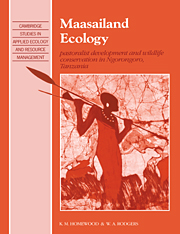Book contents
- Frontmatter
- Contents
- Preface
- 1 Management problems and applied ecology in Ngorongoro Conservation Area
- 2 Ngorongoro Conservation Area
- 3 Maasai of Ngorongoro
- 4 History, politics and perceptions in Ngorongoro
- 5 Management-oriented research in NCA
- 6 Range resources
- 7 Wildlife
- 8 Livestock ecology
- 9 Livestock and wildlife
- 10 Maasai ecology: development, demography and subsistence
- 11 Wildlife conservation and pastoralist development
- 12 Development interventions
- 13 Viewpoint
- References
- Author index
- Subject index
- Map: Ngorongoro Conservation Area, showing the main features and place names used in the text
8 - Livestock ecology
Published online by Cambridge University Press: 08 February 2010
- Frontmatter
- Contents
- Preface
- 1 Management problems and applied ecology in Ngorongoro Conservation Area
- 2 Ngorongoro Conservation Area
- 3 Maasai of Ngorongoro
- 4 History, politics and perceptions in Ngorongoro
- 5 Management-oriented research in NCA
- 6 Range resources
- 7 Wildlife
- 8 Livestock ecology
- 9 Livestock and wildlife
- 10 Maasai ecology: development, demography and subsistence
- 11 Wildlife conservation and pastoralist development
- 12 Development interventions
- 13 Viewpoint
- References
- Author index
- Subject index
- Map: Ngorongoro Conservation Area, showing the main features and place names used in the text
Summary
Erisiore entawuo nabo elukunya olee One heifer is worth a man's head
(With good management any man can become an independent stockowner) (Maasai proverb: Waller 1979)Eteyo apa nkerr: ‘Ka kirru are’ ‘The sheep once said: ‘Have you ever failed to make me two?’
(Maasai proverb: Waller 1979)The livestock production aspects of NCA have tended to be overshadowed by wildlife and archaeological conservation issues as far as international perceptions are concerned. This chapter is an attempt to redress the balance. The general nature and significance of pastoralist livestock production in sub-Saharan Africa are outlined and NCA is put in context as a case study in pastoralist ecology and management. We then go on to look at the detail of livestock ecology in NCA. Data on livestock population distribution, dynamics, range utilisation and performance are presented in comparative perspective. With this detail it is then possible to analyse the management debates within NCA on overgrazing, sustainability of land use, interactions with wildlife, and the recurrent controversy over efficiency and productivity of pastoralist performance.
Pastoralist livestock production in sub-Saharan Africa
(a) Importance of pastoralist livestock production
On the basis of ‘grain equivalents’ (e.g. Jahnke 1982) livestock production accounts for 25% of total food production in sub-Saharan Africa (excluding South Africa). Non-food products such as draught labour, manure as fertiliser and hides are also of considerable significance.
- Type
- Chapter
- Information
- Maasailand EcologyPastoralist Development and Wildlife Conservation in Ngorongoro, Tanzania, pp. 141 - 178Publisher: Cambridge University PressPrint publication year: 1991



